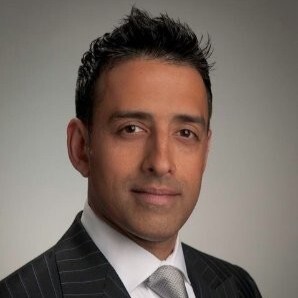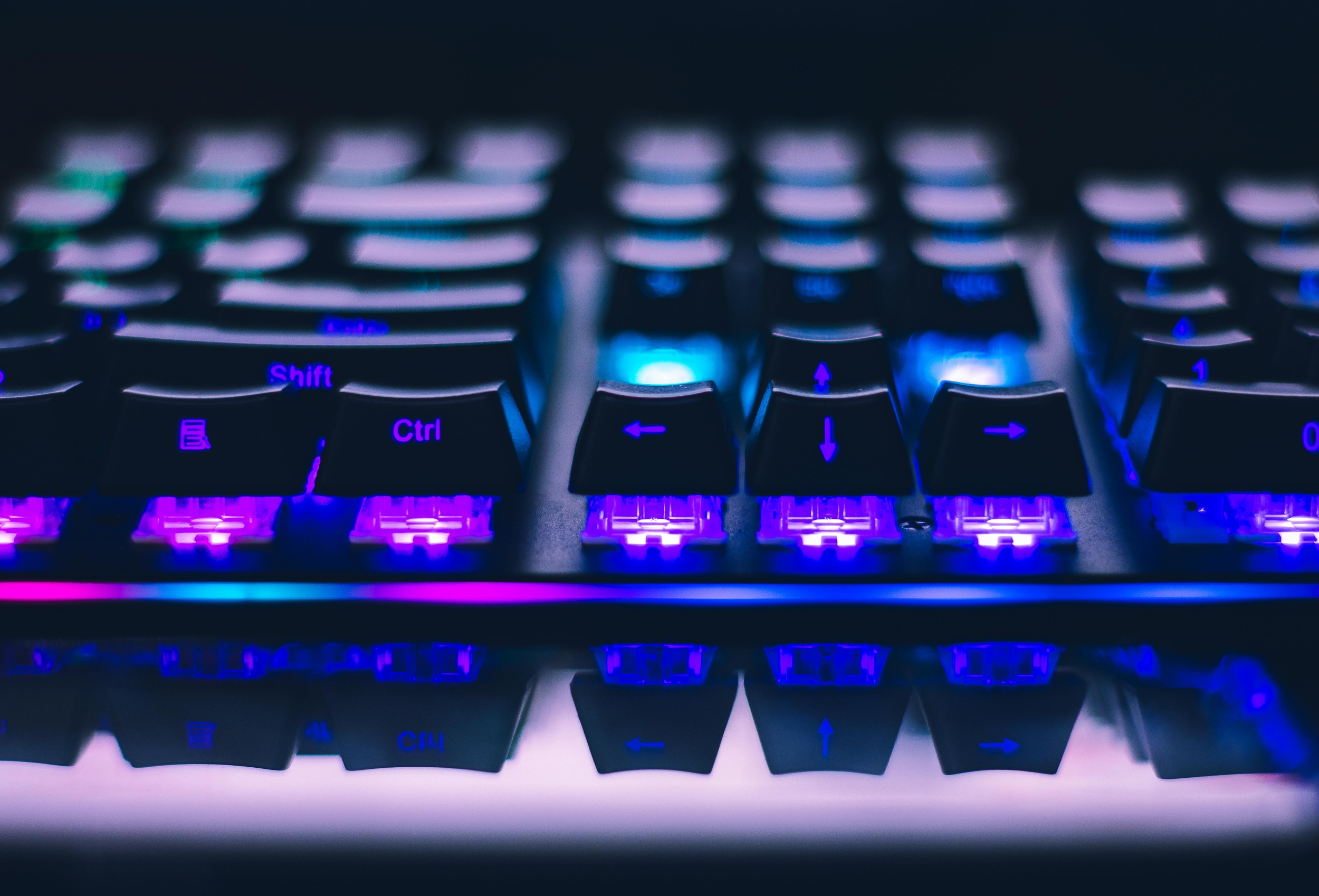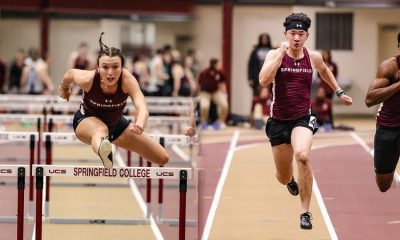Technology
As athletes face relentless pressure to outperform, AI optimizes recovery on and off the pitch |

Article authored by Nate Macleitch, CEO of HIPAA-compliant AI communications provider QuickBlox, and Sanat Dixit, MD, MBA, Neurosurgeon, Founder and CEO of Theos Health
A sprinter finishes a session and checks their phone. Within seconds, AI flagged a subtle instability in their left hip—something they didn’t feel but that, if left unchecked, could lead to a strain or worse.
Training with AI in your pocket is poised for substantial growth. The Global Sports Technology Market size is expected to be worth around $105.6 billion by 2033, from $18.7 billion in 2023, growing at a CAGR of 18.9%. It’s on the sidelines, in the locker room, and embedded in the daily routines of athletes from high school to pro leagues.
Already, the NFL has used predictive analysis to identify plays and body positions that most likely lead to injuries. The process included capturing data through chips in players’ shoulder pads, and the findings were used to adjust rules and strategies for safety. As a result, concussions sustained on kickoffs dropped by 60% in the last season.
From identifying factors that lead to injury to proposing preventative training plans, let’s look at how AI reshapes athletic performance and recovery.
Optimizing performance with AI-enabled care plans
From injury assessments to step-by-step rehabilitation exercises, AI can help provide personalized training programs and injury recovery plans.
AI is showing great promise in enhancing orthopedic surgeons’ ability to accurately diagnose injuries like ACL ruptures by automatically reviewing video footage of athletes in live situations. Critical factors that can impact an athlete’s risk of injury, such as the patient’s age, weight, number of training hours spent, previous injuries, hydration levels, and fatigue are all data points that can be inputted or recorded in real-time using wearable technology.

With an accurate and continuous flow of real-time data on all factors that influence a player’s performance, AI can analyze, predict, and adapt training plans to incorporate preventative treatment. It can target training regimes to minimize the stress on vulnerable joints and muscles and instead offer strengthening exercises and stretches to improve long-term athletic performance.
In cases where an athlete is injured, AI can help monitor whether patients are following their treatment plans correctly, and report feedback to both the athlete and clinic instantly. Paired with wearables and in some instances, AI-generated video content, athletes can ensure they are always using the correct form and movement execution.
Connecting with MSK (musculoskeletal) experts
Whether athletes are dealing with a sports injury, have chronic pain, or seek expert advice, having instant access to consultations from home can help prevent further agony.
AI, which is capable of analyzing motion and wearables data and detecting potential injuries, can also take this initial diagnosis a step further. It can categorize injury severity (e.g., mild strain vs. high ACL tear risk) and recommend next steps. This helps connect patients with the right support and ensures orthopedic surgeons prioritize urgent cases for specialist review.
Let’s say a sports clinic created its own sports injury triage and care app. It could enter its employees’ availability and use AI to match athletes with orthopedic surgeons or physical therapists based on injury type and location. AI could help automatically assign urgent cases for priority appointments, while minor injuries would be directed to rehab specialists or virtual consultations.

Getting expert care without patients stepping out of their homes—or surgeons out of the clinic—is quickly becoming the norm. The US telemedicine market size was estimated at $35.75 billion in 2024 and is expected to hit around $160.45 billion by 2034. Driving this growth is the ability to offer real-time, two-way communication platforms allowing patients to access healthcare services with improved accuracy and convenience.
Sports medicine clinics and orthopedic practices could integrate AI-assisted medical history and movement reports within their existing electronic health record (EHR) systems to centralize records and visualize biomechanical changes over time. They can use AI to auto-log movement abnormalities and correlate digital biomarker data with performance to fine-tune exercise plans. When abnormalities occur, communications platform features like automated alerts can notify medical professionals and physios to review the data, and summary features, powered by natural language processing (NLP), can help teams gain a top-level view of athletes’ symptoms as part of these alerts.
Clinician support with AI tools
AI-enabled tools won’t be replacing your healthcare provider any time soon, but they may help them become more efficient.
Healthcare has gotten more complex, and the amount of information that has to be processed has grown exponentially. Similarly, the processes to ingest, manage, and act on this information have also gotten increasingly convoluted. AI can be a valuable adjunct to streamline redundant and inefficient workflows, ranging from ambient listening and documentation tools (AI scribes), clinical decision support, patient communication, and workflow optimization.
A 2024 study in JAMA showed AI-enabled tools helped improve physician efficiency by a median of 27%. A 2022 study by the AMA also showed physicians valued the promise of this efficiency, with over 65% of physicians citing this as the primary benefit. The burdens of rote, nonclinical tasks have eroded physician morale. Leveraging AI-based tools the right way could help mitigate the problem of physician burnout.
Athletes face relentless pressure to outperform themselves and beat the latest records. As competition intensifies, athletes are turning to NLP-powered tools that translate complex data from CAMA systems and wearables into clear, real-time feedback. These tools don’t just track—they talk, guiding athletes through each micromovement like a coach in their pocket, helping them avoid injury and perform at their best.
Article authored by Nate Macleitch, CEO of HIPAA-compliant AI communications provider QuickBlox, and Sanat Dixit, MD, MBA, Neurosurgeon, Founder and CEO of Theos Health.
Technology
Fast Switches, RGB Customization, and Next-Gen Gaming Precision

Mechanical keyboard 2026models integrate ultra-fast switches that achieve 0.1ms actuation with under 1mm travel, allowing competitive gamers to press keys 20% faster in FPS and MOBA titles. RGB keyboards now feature 16.8 million per-key zones, enabling dynamic lighting that reacts to game events, killstreaks, or ability cooldowns. Hall-effect magnetic switches dominate the premium segment, offering adjustable actuation points from 0.1mm to 4.0mm while lasting 100 million keypresses with no physical wear. Together, these innovations deliver both tactile precision and immersive customization, making mechanical keyboards a vital tool for high-level competitive play.
Mechanical keyboard 2026 designs also focus on durability, ergonomics, and modularity. Hot-swappable switches allow players to fine-tune the feel without soldering. Aluminum chassis and gasket-mounted plates reduce finger fatigue while maintaining solid stability for marathon gaming sessions. Modern firmware supports thousands of macros, rapid polling rates, and dual-PC setups, ensuring that esports players experience consistent input across multiple platforms.
Fast Switches and Key Feel
Fast switches like Gateron KS-20 reduce actuation force to 35g at just 0.2mm depth, while optical variants eliminate debounce delays, registering inputs at 8,000Hz natively. Mechanical keyboard 2026 boards include hot-swappable sockets, allowing players to swap magnetic, linear, or tactile stems without soldering. PBT double-shot keycaps resist shine after five years of heavy use, and gasket-mounted designs reduce bottom-out impact, lowering finger fatigue by up to 30% during marathon sessions. Combined, these features enhance responsiveness, durability, and ergonomic comfort for both competitive and casual gamers.
Other innovations include per-key actuation calibration via onboard OLED displays, letting players fine-tune each switch’s sensitivity individually. Fast switches allow remapping for advanced trigger modes, such as assigning jump or crouch to rapid keypresses, boosting movement efficiency in FPS titles. Firmware support like VIA and QMK provides up to 1,000 macro layers, ensuring fluid execution of complex combos. NKRO (N-Key Rollover) maintains accurate detection of 100 simultaneous inputs, preventing ghosting during intense gameplay.
RGB Keyboards and Lighting Customization
RGB Gaming keyboards in 2026 employ addressable LEDs beneath every key, responding instantly to in-game actions, music beats, or voice chat activity. Fast switches synchronize with lighting effects to create visual feedback for ability activation or kill confirmations. VIA and QMK support advanced lighting macros across 16.8 million colors, letting players design immersive themes and reactive effects. RGB keyboards also integrate USB passthrough hubs, enabling controller charging or peripheral connections without latency interruptions.
Premium gaming screens emphasize both aesthetic and functional benefits. Aluminum chassis with acoustic foam layers tune sound profiles from soft, creamy thocks to sharp, clicky clacks, complementing per-key lighting for sensory immersion. RGB keyboards combined with modular keycaps allow instant visual recognition of critical keys, enhancing reaction times in high-pressure matches. Firmware updates maintain compatibility with new software and games, ensuring that RGB functionality evolves alongside gaming trends.
Build Quality and Advanced Features
Mechanical keyboard 2026 models focus on robust materials and ergonomic design to support competitive play. Aluminum top plates weigh around 1.2kg, stabilizing 60% or full-size layouts, while foam and gasket mounting reduce vibration and noise. Fast switches with Hall-effect sensors allow precise calibration and onboard memory, storing personalized actuation and lighting settings.
Other features include multi-device support, 8,000Hz polling across dual-PC setups, and modular layouts for hybrid gaming and productivity. High-end models provide long-term durability, with switches rated for 100 million keypresses and chassis built to withstand sustained pressure. These designs ensure that both casual players and esports professionals can maintain peak performance over years of intense use.
Key Features:
- Aluminum top plates provide stability and long-lasting structural integrity.
- Foam and gasket-mounted designs reduce vibration, noise, and finger fatigue.
- Hall-effect fast switches allow precise per-key calibration and storage.
- Modular layouts and multi-device support enhance versatility for gaming and work.
- 8,000Hz polling ensures sub-ms latency across dual-PC or multi-system setups.
- Switches rated for 100 million keypresses guarantee long-term durability.
Conclusion
Mechanical keyboard 2026 models with fast switches and RGB keyboards redefine both competitive precision and immersive gameplay experiences. Adjustable actuation, ultra-fast response times, and reactive per-key lighting provide measurable advantages in esports, allowing players to execute rapid combos and maintain visual awareness under intense pressure. Durable materials, modular layouts, and advanced firmware ensure 10+ years of relevance, keeping performance consistent even as switch technology evolves. Combined, these innovations set a new benchmark for gaming keyboards, making them an indispensable tool for casual enthusiasts and professional gamers alike.
Frequently Asked Questions
1. What makes mechanical keyboard 2026 switches faster than older models?
Mechanical keyboard 2026 switches achieve 0.1ms actuation with minimal travel, reducing input delay. Optical switches eliminate debounce entirely. Hot-swappable designs allow users to optimize each switch type. Together, they improve reaction times in competitive gaming.
2. How do RGB keyboards enhance gaming performance?
RGB keyboards provide per-key lighting for instant visual cues on ability cooldowns, killstreaks, or critical keys. Reactive effects improve reaction speed in high-pressure scenarios. Custom macros allow lighting to indicate complex input sequences. This combination merges aesthetics with functional gameplay advantages.
3. Are fast switches durable enough for long-term use?
Yes, Hall-effect and magnetic switches are rated for 100 million keypresses. Gasket-mounted designs reduce mechanical wear and finger fatigue. PBT double-shot keycaps resist shine and degradation. Long-term durability ensures consistent performance for years.
4. Can mechanical keyboard 2026 models support multi-device setups?
Many models integrate USB passthrough hubs for peripherals and dual-PC support. 8,000Hz polling ensures sub-ms latency across connected devices. Firmware allows separate profiles per device. This setup guarantees smooth operation for both gaming and productivity tasks.
Technology
How Schools Are Powering the Future of Competitive Gaming Education

The world of esports has rapidly shifted from a niche form of entertainment to a central component of competitive gaming education. As 2026 approaches, academic institutions across the globe are embracing the opportunities that digital competition presents.
From high school classrooms to university campuses, structured gaming programs in schools are transforming how students learn, collaborate, and prepare for the digital economy.
The Explosive Rise of Esports in Education
Esports, once dismissed as mere gaming, now attracts millions of players and spectators around the world. Educational institutions have taken notice. The steady growth in digital engagement, streaming culture, and student interest has pushed schools to formally integrate esports into their extracurricular and academic offerings.
By 2026, experts project that school-based esports participation will surpass that of traditional high school sports in some regions. The digitization of competitive gaming aligns with broader trends in modern education, where technology, inclusivity, and creativity intersect to form new learning pathways.
What Is Esports and Why Is It So Popular Among Students?
Esports refers to organized, competitive video gaming, often involving professional players and teams. Unlike casual gaming, esports involves structured tournaments, ranked leagues, and strategy-based team play across popular titles such as League of Legends, Valorant, and Rocket League.
For students, esports blends entertainment with purpose. It enables individuals who may not participate in traditional athletics to compete, build communities, and express creativity. The widespread availability of gaming hardware, streaming tools, and online platforms has lowered the entry barrier, making esports more accessible than ever.
Moreover, the social component is powerful. Online tournaments and school leagues foster connection across diverse backgrounds, helping students develop coordination, leadership, and interpersonal skills, traits that are increasingly valuable in both academic and corporate environments.
How Are Schools Launching Esports Programs?
Many schools have already launched formal esports programs, driven by student demand and institutional recognition of esports’ educational potential. Universities in the United States, South Korea, and the Philippines are establishing dedicated esports departments that oversee teams, manage scholarships, and organize intercollegiate competitions.
High schools are following suit. Some districts are converting computer labs into esports arenas equipped with high-performance PCs, ergonomic setups, and broadcast equipment. Others collaborate with gaming companies to create mentorship and training initiatives, blending classroom theory with real-world competition.
These gaming programs in schools go beyond playing. They involve curriculum design, technical training, and content creation workshops that align esports with the broader educational framework. Students learn not only how to compete but also how to analyze performance data, manage teams, and produce digital media.
What Do Students Learn from Competitive Gaming Education?
The rise of competitive gaming education is reshaping the skillsets associated with modern learning. Students gain more than just gaming proficiency, they develop critical thinking, multitasking, and collaboration abilities. These programs emphasize transferrable skills such as problem-solving, adaptability, and emotional regulation under pressure.
Esports also complements existing curricular areas. Game strategy mirrors elements of mathematics and physics, while coding and hardware management connect directly to STEM learning. Instructors use esports to teach topics such as network infrastructure, software development, and game design.
Beyond academics, competitive gaming encourages inclusivity. Students of all genders, backgrounds, and physical abilities can participate on equal footing, fostering school pride and teamwork in digital spaces.
How Big Will Esports Be by 2026?
Industry analysts predict that esports in 2026 will be valued at over $2 billion globally, with an audience exceeding 800 million. This rapid growth is fueled by live-streaming platforms, increasing sponsorship deals, and more educational integration.
Esports’ reach continues to expand beyond traditional entertainment. Virtual reality and augmented reality are enhancing gameplay engagement, while blockchain-based tournament systems are adding transparency to competition and prize distribution.
The integration of AI analytics is also reshaping coaching methods. Educators and team managers are using data-driven insights to assess player performance, optimize team composition, and develop customized training regimens. As schools adopt these same analytical tools, competitive gaming education enters a new era, where digital literacy and innovation drive progress.
What Challenges Do Schools Face in Running Esports Programs?
Despite the enthusiasm surrounding esports, schools still face practical and ethical challenges. One major concern is balancing academics with gaming commitments. Without structured supervision, students may risk excessive screen time or burnout.
Institutions are addressing this by introducing strict schedules, physical activity requirements, and mental health counseling. Another challenge involves funding. Setting up professional-grade arenas and securing reliable hardware demand significant investment. Public schools in particular rely on sponsors or partnerships with tech firms to maintain program sustainability.
Finally, schools must train or hire qualified esports coaches who understand both the educational context and the competitive scene. This dual expertise ensures that gaming remains an avenue for learning, not just recreation.
Success Stories: Schools Leading the Way in Esports Education
Several schools around the world have already demonstrated how esports can enhance education. In the United States, the High School Esports League (HSEL) connects thousands of students nationwide, fostering academic engagement and teamwork. Schools such as Miami University and the University of Utah became early adopters of varsity esports teams, setting benchmarks for collegiate competition.
In Asia, South Korea remains a trailblazer. Its government has integrated esports into youth programs, emphasizing both technical training and player well-being. Meanwhile, in the Philippines, some universities have begun offering esports courses as part of information technology programs, mirroring global trends toward curriculum innovation.
These examples prove that when implemented responsibly, esports programs can increase student enrollment, improve school visibility, and create bridges between education and industry.
The Future of Competitive Gaming Education Beyond 2026
Beyond esports 2026, the intersection of competitive gaming and education will likely deepen. Analysts foresee a future where esports becomes as normalized as traditional athletics, with intramurals, leagues, and international tournaments structured at school and university levels.
The global shift toward online learning has also paved the way for hybrid esports education models, combining remote play with in-person coaching. Additionally, certifications in health and psychology related to esports are expected to emerge, helping educators manage player wellness and team dynamics effectively.
Cross-border collaborations may soon unite students from different regions in global esports competitions, promoting cultural exchange and digital diplomacy through gameplay.
Frequently Asked Questions
1. Can esports help improve students’ academic performance?
Yes. Organized esports can boost focus, strategic thinking, and time management. Students in competitive gaming education often show stronger problem-solving and teamwork skills that support academic success.
2. What are the career opportunities for students who study esports?
Students can pursue careers in event management, broadcasting, analytics, marketing, and game design. Many esports 2026 programs also prepare graduates for tech and media-related fields.
3. How do schools choose which games to include in their esports programs?
Schools select games that promote teamwork, critical thinking, and inclusivity. Titles like Rocket League and League of Legends are common in gaming programs in schools due to their balance of strategy and accessibility.
4. Do esports programs promote diversity and inclusion in education?
Yes. Esports welcomes students from all backgrounds, offering equal opportunities regardless of physical ability or gender. Many schools use competitive gaming education to foster inclusivity and community.
Technology
Xpoint secures new growth funding supercharging RMG geolocation innovation – Casino & games

Bettor Capital leads the round as Xpoint accelerates product development and global deployment.
Xpoint, a leading geolocation and compliance technology partner to the online real‑money gaming industry, today announced a fresh investment round led by existing investor Bettor Capital.
The capital will fast‑track Xpoint’s R&D roadmap and expand its product and engineering teams, accelerating delivery of next‑generation capabilities to operators worldwide.
Built for gaming from the ground up, Xpoint’s adaptable platform combines fast, accurate precision geofencing with advanced fraud detection to stop spoofing, block unauthorised wagers and surface suspicious activity in real time, helping operators launch and scale confidently in online real-money gaming markets.
With flexible integration and rapid deployment tailored to sportsbook, iCasino, lottery, DFS and sweepstakes use cases, Xpoint provides audit ready compliance automation across multi-state and international markets. The platform also offers unique, patent-pending algorithms at jurisdictional borders to protect revenues and reduce player friction and drop off.
Xpoint’s recent momentum includes successful active and pending deployments with leading brands such as Bet365 and PrizePicks in North America, with more to be announced soon. Xpoint is also live with clients in Brazil and the UAE, including the UAE Lottery and Play971, the first regulated online gaming and sports betting entity in the region.
“This new funding lands at the perfect time for our growth,” said Manu Gambhir, CEO of Xpoint. “We’re scaling up our teams to ship a wave of new capabilities that help operators defeat location spoofing, streamline compliance and convert more good users – without compromising on precision, scale, or speed.”
“We are delighted to significantly increase our commitment to Xpoint to accelerate product development and deployment”, added David Van Egmond, founder and managing Partner at Bettor Capital. “In this industry, robust regulatory and compliance technology is absolutely essential and Xpoint has proven to consistently deliver substantial value to a growing roster of real-money online gaming operators.”
New Jersey–based Bettor Capital is a venture capital firm specialising in early‑stage investments in technology companies within the real‑money online gaming ecosystem. Bettor Capital was among Xpoint’s first institutional backers and has increased its investment over time.
Technology
ASUS Seizes Market Leadership in the OLED Monitor Market as Shipments Soar in 2025

This milestone underscores the company’s commitment to delivering more than just monitors – it reflects a user-first strategy focused on elevating the overall display experience. By expanding its OLED portfolio across both QD-OLED and WOLED technologies for gaming, professional, and creator segments, ASUS ensures solutions are tailored to diverse user needs. Unique innovations such as OLED Care Pro, Neo Proximity Sensor, TrueBlack Glossy, and DisplayWidget Center go beyond performance, enhancing usability, longevity, and visual immersion. This consumer-centric approach transforms OLED monitors into a complete experience, driving user preference for ASUS products and solidifying the company’s position as the No. 1 OLED market leader.

Driving growth through innovation and diversity
ASUS is accelerating its OLED momentum through a broad, innovation-driven portfolio that spans gaming, creator, and professional segments – leveraging advanced panel technologies, robust burn-in protection, and rapid product launches to meet the needs of a diverse and growing user base.
- Broad product lineup: ASUS launched a wide array of OLED monitors in 2025, targeting everything from competitive esports to high-fidelity content creation.
- Advanced OLED technologies: New models, such as the ROG Swift OLED PG27AQWP-W and ROG Strix OLED XG27AQWMG, integrate Tandem OLED technology and TrueBlack Glossy coating, delivering higher peak brightness, wider color volume and enhanced panel longevity.
- Burn-in protection: Proprietary ASUS OLED Care Pro suite – including the Neo Proximity Sensor – helps safeguard panel lifespan by switching the display to a black screen when no user is detected.
- Rapid product cadence: In early 2025, ASUS introduced the 27-inch QD-OLED ROG Swift PG27UCDM (4K @ 240 Hz) and the blazing-fast ROG Strix XG27AQDPG (1440p QD-OLED @ 500 Hz).
Market momentum and strategic vision
TrendForce data reveals that OLED monitor shipments are growing at a breakneck pace – surging by 65% year over year in Q3 2025, with global shipments reaching 644,000 units. The increasing popularity of OLED displays for gaming has been a major, but not the only factor in this growth. As OLED panel technology continues to gain traction among gamers, the strategic investment and execution by ASUS have allowed it to rise swiftly in market share, overtaking long-time rivals.
Beyond gaming, ASUS ProArt OLED monitors are a favorite among content creators who need to pair next-level contrast and color performance with professional-grade accuracy, multiple HDR format support, wide-ranging connectivity, and intelligent calibration tools. ASUS ZenScreen OLED monitors give PC users of all kinds the superior color performance of OLED panels in a portable form factor.
Vincent Chiou, ASUS Global Vice President and General Manager of the Display Business Unit, observed: “ASUS has long been dedicated to innovation in display technology and impeccable quality. In addition to receiving high praise from gamers, the industry-leading ROG gaming monitors and the ProArt series designed for content creators have also made significant inroads into portable and medical fields, earning widespread recognition and favor. Moving forward, ASUS will continue to prioritize user needs at its core, delivering an unparalleled visual experience to consumers.”
The ASUS commitment to innovation
PC users of all kinds can expect to see ASUS to continue to innovate in this space with new OLED monitors that debut new panel technologies into diverse form factors, deliver enhanced reliability and performance in a variety of usage scenarios, and push the envelope with even higher-performance designs.
Technology
Brightspeed invests $580,000 in STEM and esports, supporting North Carolina schools and programs — EdTech Innovation Hub

The new funding announced will support schemes including $350,000 in sponsorship of the Coca Cola All Stars Golden Ticket contest, Formula STEM Esports Cup and the Player League Madden NFL tournament.
Brightspeed will also act as a primary sponsor for two Bright Future Tech Labs in Triton High School and Orange High School, with funding worth more than $200,000.
The company will also spend $15,000 on scholarships, equipment, and esports program travel for Wesleyan University and $10,000 on a grant supporting the Rocky Mount High School Gryphon Elite esports team.
Brightspeed has also announced sponsorship for the Wake Forest Parks, Recreation and Cultural Resources Department’s four-part esports tournament, called the Battle in the Forest.
“Investing in technology education and esports is a natural extension of our commitment to North Carolina,” explains Sabrina Anderson, Local Marketing Manager at Brightspeed.
“As we build a world-class fiber network across our home state, we’re equally focused on expanding opportunities for the students who will power our communities tomorrow. These initiatives give young people hands-on access to the tools, skills and experiences that prepare them for the digital future.”
“This scholarship will help ease the financial burden my parents carry in supporting my academic journey,” adds Shafiq Nuijts, a Wesleyan University student and recipient of Brightspeed funded scholarship. “It will also allow me to focus more deeply on my education and my internship this upcoming summer. As an international student, my experience has always involved balancing the challenges of maintaining my F-1 status, keeping a high GPA and reassuring my parents that their investment in me is being put to meaningful use. This scholarship affirms that commitment and motivates me to continue striving for excellence.”
Technology
Gaming Computers Market to Reach USD 95 Billion by 2034, Growing


Gaming Computers Market
Pune, India – Exactitude Consultancy – The global Gaming Computers Market is expected to witness strong growth over the forecast period, driven by the rising popularity of esports, increasing demand for high-performance computing, and continuous advancements in graphics and processor technologies. The market, valued at approximately USD 44 billion in 2024, is projected to reach nearly USD 95 billion by 2034, expanding at a compound annual growth rate (CAGR) of about 7.9%.
Gaming computers, including desktops and laptops, are designed to deliver superior performance, high-resolution graphics, and fast processing speeds to support immersive gaming experiences. Growing online gaming communities and professional gaming platforms are further accelerating market growth.
Download Full PDF Sample Copy of Market Report
https://exactitudeconsultancy.com/request-sample/69340
Key Growth Drivers
• Rapid Growth of Esports and Online Gaming: Competitive gaming tournaments and streaming platforms are boosting demand for high-performance gaming systems.
• Advancements in Hardware Technology: Continuous improvements in GPUs, CPUs, cooling systems, and memory are enhancing gaming performance.
• Rising Disposable Income: Increasing consumer spending on premium electronics is supporting adoption of gaming computers.
• Expansion of Virtual and Augmented Reality Gaming: Demand for powerful computing systems to support VR and AR applications is increasing.
Market Segmentation Insights
By product type, gaming desktops hold a significant share due to superior customization and performance, while gaming laptops continue to gain popularity for portability.
By price range, mid-range and high-end systems dominate the market, driven by demand from professional and enthusiast gamers.
By end user, individual consumers account for the largest share, followed by gaming cafes and esports organizations.
Explore Full Report here:
https://exactitudeconsultancy.com/reports/69340/gaming-computers-market
Regional Overview
Asia-Pacific represents the largest and fastest-growing regional market, supported by a large gamer population, strong esports culture, and expanding gaming infrastructure in countries such as China, South Korea, Japan, and India.
North America shows strong growth driven by high adoption of advanced gaming hardware and a mature esports ecosystem.
Europe continues to expand steadily due to rising gaming participation and technological innovation.
Latin America and the Middle East & Africa are emerging regions, supported by increasing internet penetration and growing gaming communities.
Get Your Exclusive Offer with up to 10% Discount
https://exactitudeconsultancy.com/checkout/?currency=USD&type=single_user_license&report_id=69340
Competitive Landscape
The gaming computers market is highly competitive, with major players focusing on performance optimization, innovative designs, and brand partnerships. Companies are investing in advanced cooling technologies, RGB customization, and AI-enabled performance tuning to differentiate their offerings.
Market Outlook
With the gaming industry continuing to evolve rapidly, the Gaming Computers Market is expected to experience sustained growth through 2034. Increasing esports adoption, next-generation gaming technologies, and expanding digital entertainment consumption will remain key drivers of market expansion.
This report is also available in the following languages : Japanese (ゲーミングコンピュータ市場), Korean (게이밍 컴퓨터 시장), Chinese (游戏电脑市场), French (Marché des ordinateurs de jeu), German (Markt für Gaming-Computer), and Italian (Mercato dei computer da gioco), etc.
Request for a sample of this research report at (Use Corporate Mail ID for Quick Response) @
https://exactitudeconsultancy.com/request-sample/69340
Our More Reports:
Redundant EPS System Market
https://exactitudeconsultancy.com/reports/69077/redundant-eps-system-market
InGaAs Image Sensors Market
https://exactitudeconsultancy.com/reports/68951/ingaas-image-sensors-market
Ceramic Electrostatic Chucks Market
https://exactitudeconsultancy.com/reports/68953/ceramic-electrostatic-chucks-market
Electrical Wires Market
https://exactitudeconsultancy.com/reports/68955/electrical-wires-market
About Us
Exactitude Consultancy is a market research & consulting services firm which helps its client to address their most pressing strategic and business challenges. Our market research helps clients to address critical business challenges and also helps make optimized business decisions with our fact-based research insights, market intelligence, and accurate data.
https://bulletin.exactitudeconsultancy.com/
https://www.thehealthanalytics.com/
https://www.analytica.global/
https://www.marketintelligencedata.com/
https://www.marketinsightsreports.com/
https://exactitudeconsultancy.com/
Connect Us:
Irfan Tamboli
PHONE NUMBER +1 (704) 266-3234
EMAIL ADDRESS: sales@exactitudeconsultancy.com
This release was published on openPR.
-

 Motorsports1 week ago
Motorsports1 week agoSoundGear Named Entitlement Sponsor of Spears CARS Tour Southwest Opener
-

 NIL3 weeks ago
NIL3 weeks agoBowl Projections: ESPN predicts 12-team College Football Playoff bracket, full bowl slate after Week 14
-

 Rec Sports3 weeks ago
Rec Sports3 weeks agoRobert “Bobby” Lewis Hardin, 56
-
Sports3 weeks ago
Wisconsin volleyball sweeps Minnesota with ease in ranked rivalry win
-

 Motorsports2 weeks ago
Motorsports2 weeks agoDonny Schatz finds new home for 2026, inks full-time deal with CJB Motorsports – InForum
-

 Rec Sports2 weeks ago
Rec Sports2 weeks agoHow Donald Trump became FIFA’s ‘soccer president’ long before World Cup draw
-

 Sports3 weeks ago
Sports3 weeks agoMen’s and Women’s Track and Field Release 2026 Indoor Schedule with Opener Slated for December 6 at Home
-

 Motorsports3 weeks ago
Motorsports3 weeks agoMichael Jordan’s fight against NASCAR heads to court, could shake up motorsports
-

 Rec Sports2 weeks ago
Rec Sports2 weeks agoBlack Bear Revises Recording Policies After Rulebook Language Surfaces via Lever
-

 Motorsports2 weeks ago
Motorsports2 weeks agoJR Motorsports Confirms Death Of NASCAR Veteran Michael Annett At Age 39































